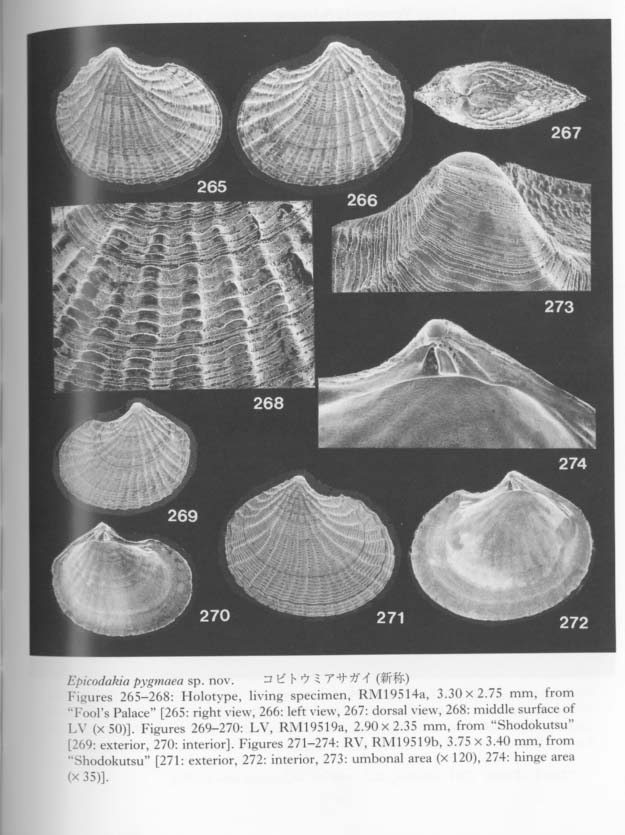Subclass Heterodonta Neumayr, 1884
Order Lucinoida Dall, 1889
Superfamily Lucinoidea Fleming, 1828
Family Lucinidae Fleming, 1828
Subfamily Lucininae Fleming, 1828
Genus Epicodakia Iredale, 1930
Epicodakia pygmaea sp. nov.
Figures 265-274

1992. Epicodakia sp., Kase and Hayami, Jour. Moll. Studies, vol.58, p.448, listed.
Type and material.— Holotype: RM19514a, a living specimen, from the bottom sediments of "Fool's Palace" of Shimoji Islet, Miyako Islands. Paratypes: RM19513 (living) from "Devil's Palace", RM19514 (living) from the type locality, RM19515 (dead) from "Black Hole" of Shimoji Islet. RM19516 (living) from "Lunch Hole", RM19517 (dead) from "W-arch", RM19518 (living) from "Cross Hole" of Irabu Islet. RM19S19 (dead) from "Shodokutsu" of Ie Islet.
Diagnosis.— Very small-sized species of Epicodakia, characterized by anteriorly expanded shell, posteriorly located umbo, deeply concave pre-umbonal margin, irregularly increased divaricate ribs, well-developed commarginal lamellae, and hinge teeth typical of the genus.
Description.— Shell minute, rarely exceeding 4.0 mm in length, about 1.2 times longer than high, reddish brown when alive, comparatively thick, anteriorly expanded, not strongly inflated. Umbo small, salient, slightly prosogyrous, placed at about three-fifths of shell length from anterior end. Antero-dorsal margin deeply concave, forming an obtuse angle with anterior margin. Postero-dorsal margin very short, nearly straight, forming a rounded angle with ventral margin. Lunule indistinct. Surface wholly covered with numerous regularly spaced commarginal lamellae which are interrupted by irregularly increasing slender divaricate ribs. Marginal crenulations undeveloped. Ligament external but inframarginal. Hinge teeth typical of Epicodakia, as formulated: AIII (AI) (3a) 3b PIII/AIV All 2 4b PILPIV ; 2 and 3b triangular; 4b thin, 3a not clearly separated from nymph margin, and lateral teeth tubercular, distant, located near antero-dorsal and postero-dorsal angulations. Pd I relatively large, about 150 µm in maximum diameter, though Pd II is also distinct.
Remarks.— Although the adult shell may be unusually small, the present species is referable to Epicodakia by the divaricate ornaments and hinge structure typical of the genus. However, the anteriorly expanded shell, posteriorly located umbo, delicate commarginal lamellae, slender divaricate ribs and remarkably concave antero-dorsal margin seem to constitute diagnostic characters for distinguishing the present species from hitherto described species of this genus.
Distribution.— Rare in several sublittoral caves of Ie, Shimoji and Irabu Islets, Ryukyu Islands.